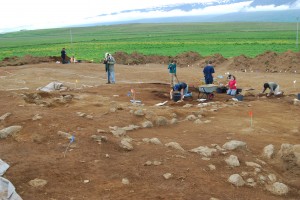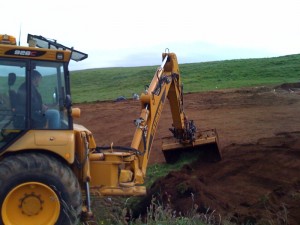June 30, 2009
by Kathryn Catlin
0 comments
Hi! I’m Katy, an incoming graduate student at UMass Boston. I’ll be writing some blog posts while we’re in Iceland this summer!
Today we were at Stóra-Seyla, a Viking-era farmstead a few miles outside of Sauðárkrókur. SASS has worked it for several years in a row, so the site was under a layer of "geotextile," which was under a thick layer of turf. Also, we want to do ground-penetrating radar on another part of the site, so another huge area needed to be cleared of turf and smoothed before we can start that.
Here’s what the site looked like when we got there:

We spent two hours busting sod and shoveling it off the cloth; then we had a coffee break, and then spent two more hours shoveling. I took some pictures:

The horses were fighting at various points throughout the day.

These guys were out matching the site with data from last year, and planting flags to mark the boundaries.
Then we had a lunch break, and the backhoe finally showed up!

But then we still had to spend three more hours shoveling off the parts too delicate for the backhoe. The backhoe mostly cleared off the area intended for GPR and moved away our dirt piles that resulted from shoveling.
Then we had another coffee break, and then we spent the last couple of hours shovel-scraping half the GPR area so the machine will be able to move over it smoothly.
We did run into a tephra layer while shovel scraping, and we also encountered a couple of pieces of historic (19-20th c) ceramic pieces, which we will track store separately from the Viking-era artifacts we should be finding later.
And this is what it looked like after we left:

The part we did by hand is the lighter-colored stuff in the front. The backhoe did the rest. The part on the left that looks smoother is where we shovel-scraped.
It was cold, but not *too* cold, and sprinkled sporadically. Tomorrow we’re going to finish shovel scraping and probably also finish shoveling off the previously excavated walls. And for a big chunk of the day we’re going on a Turf Tour, to learn how to recognize various types of turf houses in varying states of decay. Stay tuned!








